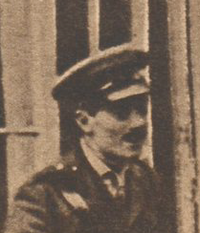Christopher Thomson, 1st Baron Thomson
|
The Right Honourable The Lord Thomson PC |
|
|---|---|

as defence attache in Bucharest
|
|
| Secretary of State for Air | |
|
In office 22 January 1924 – 3 November 1924 |
|
| Monarch | George V |
| Prime Minister | Ramsay MacDonald |
| Preceded by | Sir Samuel Hoare, Bt |
| Succeeded by | Sir Samuel Hoare, Bt |
|
In office 7 June 1929 – 5 October 1930 |
|
| Monarch | George V |
| Prime Minister | Ramsay MacDonald |
| Preceded by | Sir Samuel Hoare, Bt |
| Succeeded by | The Lord Amulree |
| Personal details | |
| Born |
13 April 1875 Nasik, British India |
| Died |
5 October 1930 (aged 55) Allone, France |
| Resting place | Cardington, Bedfordshire |
| Nationality | British |
| Political party | Labour |
Christopher Birdwood Thomson, 1st Baron Thomson PC (13 April 1875 – 5 October 1930) was a British Army officer who went on to serve as a Labour minister and peer. He served as Secretary of State for Air under Ramsay MacDonald in 1924 and between 1929 and 1930, when he was killed in the R101 disaster.
Born in Nasik (now Nashik) in the Bombay Presidency of India to a military family, Thomson attended Cheltenham College. His father was Major-General David Thompson, Royal Engineers, and his mother was the daughter of Major-General Christopher Birdwood; William Birdwood, 1st Baron Birdwood was another grandson of Major-General Birdwood.
After graduating from the Royal Military Academy, Woolwich, in 1894, Thomson was commissioned into the Royal Engineers. He served first in Mauritius and then saw action during the Second Boer War (1899-1902) during which he was in command of a field company section and was mentioned in dispatches. He also had his first encounter with aviation when he was detailed to help with the RE Balloon Section outside Kimberley. After the war he became an instructor at the School of Military Engineering at Chatham and then at Sierra Leone. He was promoted to captain and brevet major in 1904 and in 1909 joined the Army Staff College in Camberley. In 1911 he went to the War Office, and in 1912 Thomson was appointed military attaché with the Serbian army during the first and Second Balkan Wars, after which he returned to the War Office in 1913.
...
Wikipedia
